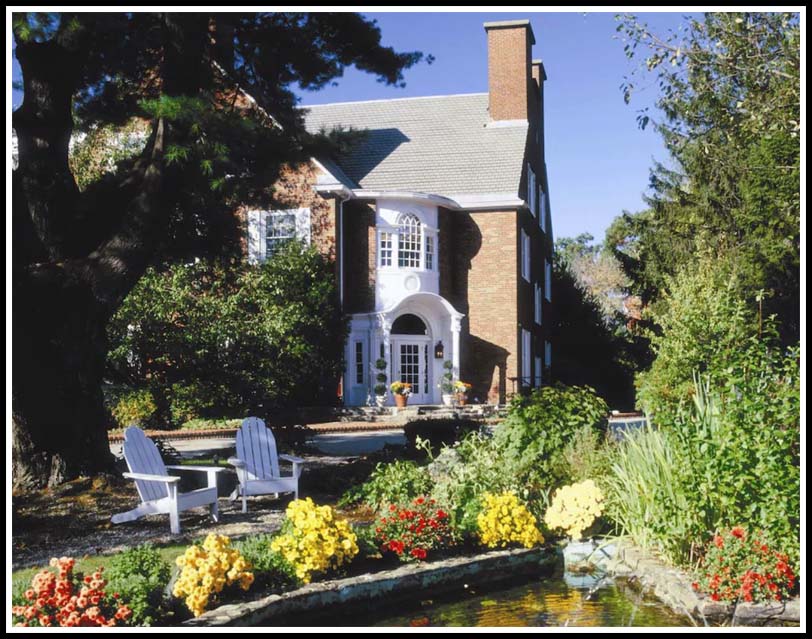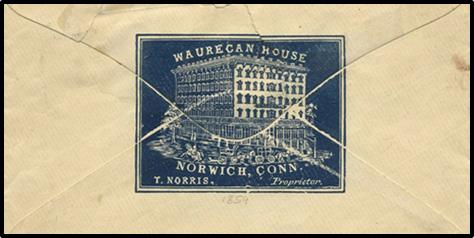The Spa at Norwich Inn
“Built in 1929, the original Norwich Inn was a haven for the rich and famous, drawing such luminaries as George Bernard Shaw, Charles Laughton, Frank Sinatra, Shirley Temple, and the Prince of Wales. The Inn benefited not only from its premium location, midway between New York and Boston in beautiful eastern Connecticut, but also from the word-of-mouth inspired by its architectural elegance and unrivaled surroundings. The classic Georgian Colonial revival structure, with its handsome front portico, door, and fanlight, included 75 guestrooms and boasted an expansive, rolling golf course.”

“The Inn changed hands several times in the years surrounding the Second World War, and eventually, a period of gradual decline set in. The fortunes of the property hit bottom when, having been purchased by the City of Norwich, the core structure was operated as a boardinghouse, while the basement was used as a holding tank for overflow prisoners from the police department.”
Excerpt from “The Spa at Norwich Inn” website
The sources and bibliography, listed below, contain a much more complete history of the spa.
Acknowledgements
The Spa at Norwich Inn website
Travelocity
The complete list of sources may be found by clicking the “Bibliography” button, and, then typing “Spa at Norwich Inn” in the SEARCH box.
Joseph Teel House

The Joseph Teel house, built in 1789-1790, is located on Chelsea Parade South between Washington Street and Broadway. It was built on a portion of the original Adgate lot.
It was built as an inn several years after the Revolutionary War with the name “At the Sign of General Washington.” The tavern, owned and operated by Joseph Teel, is a 3-story Federal-style brick mansion. The 3rd floor has a ballroom that has been used to host balls, entertainment, social gatherings, and club meetings for many years.
Teel placed an advertisement on May 29, 1794, announcing the arrival of a party of Italian rope dancers and tumblers. The public was invited to see Don Peter and Clumsy the Clown perform a hornpipe dance while blindfolded on fifteen eggs.

Italian Rope Dancers
A rope-dancer is a person who performs acrobatics upon a rope stretched above the floor. The art of rope walking/dancing was practiced by the ancient Greeks and Romans. The Romans called them funambulists.
In the early 1700s Signora Violante was a famous Italian (possibly French) rope-dancer who performed with her husband and children throughout Europe. Her descendants became part of the famous Lupino family, who performed throughout England. It is unknown which troupe of rope-dancers performed at the Teel House.
Later, in the 1859, aerial entertainment was furthered developed with the invention of the flying trapeze by French acrobat Jules Léotard. He also popularized the one-piece gym wear that now bears his name and inspired the 1867 song “The Daring Young Man on the Flying Trapeze”.
In June 1800, the hotel was subsequently transformed into a boarding and day school operated by William Woodbridge. For many years the Teel House was the home of General William Williams and his wife Harriet Peck Williams. William donated 7 ½ acres of land on which Norwich Free Academy is built, and his wife Harriet Peck Williams donated the school’s first library and the land upon which Park Congregational Church sits.
In 1895 the house served as a parsonage for the Park Congregational Church, and then later yet is was the home of Norwich Free Academy’s headmaster. Today it is a private residence.
The Teel House is a contributing property of the Chelsea Parade Historic District, which is on National Register of Historic Places.
Acknowledgements
“History of Norwich, Connecticut: From Its Possession From the Indians, to the Year 1866,” p 555, by Frances Manwaring Caulkins
New York Public Library
Bob Dees
The complete list of sources may be found by clicking the “Bibliography” button, and, then typing “Joseph Teel House” in the SEARCH box.
Wauregan Hotel
The Wauregan Hotel, located in downtown Norwich, first opened its doors on February 20, 1855. Over the past 165 years it has hosted many distinguished guests, countless meetings and events, and recently, has been the home for many tenants. The Wauregan has experienced both great celebrations and contentious debate over the years.
The originally named Wauregan House was funded by a consortium of businessmen and community leaders with the idea in mind that it would provide ample accommodation for visitors and be an ornament to the city.

It was designed by Evan Burdick, the same architect who designed Norwich Free Academy’s first building. The NFA building opened the year after the Wauregan House. The Wauregan House was adorned with Italianate cast iron ornaments and balconies. Its original cost was $50,000 ($1,356,000 in today’s dollars).
Three months after opening, the Wauregan was given permission to offer visitors the most modern of conveniences; gas lighting. The Wauregan was the first large building in downtown Norwich to be lighted with gas from the newly formed Norwich City Gas Company.


The back of this 1859 envelope was stamped with an engraving of the Wauregan House.
The Wauregan Hotel letterhead shown here is an example of elegance provided to its guests.
*Place cursor over image to magnify
The Wauregan soon became known as one of the finest hotels in New England. In 1859, when the 200th Jubilee of Norwich was celebrated, citizens gathered directly in front of the Wauregan to view a grand procession featuring Governor William A. Buckingham and former President Millard Fillmore.
The parade was HUGE! There were 10 divisions, (i.e. large groups of people marching in the parade), each led by a prominent Norwichian. The procession, which began at 10:00 am, meandered from Franklin Square through town. It arrived at Chelsea Parade a little before 1:00 pm.
In 1860 Abraham Lincoln was a guest of the Wauregan when visited Norwich during his presidential campaign.
The Wauregan has changed dramatically over the years, yet its charm is still present today.
The hotel expanded in 1894 with the absorption of the neighboring Clarendon Building. The expansion added a dining room and a ballroom. The ballroom, as seen in 2010, is shown in the photo on the left.
The postcards and photo shown below illustrate how the Wauregan appeared in 1924, 1947, and in 2010.
1924 : Wauregan Hotel
1947 : Wauregan Hotel
2010 : Wauregan Apartments
By the 1940s the building’s Italianate cast iron ornamentation had been removed. Abandoned for many years and in a deteriorating condition the Wauregan Hotel was in danger of demolition. In 1990 a fire in the furnace room resulted in the closure of the building and its condemnation. However, a major preservation effort was organized in the early 21st century.
After a great deal of contentious debate, a major restoration commenced in 2005 to restore and repurpose the Wauregan to its original level of prominence. The architectural detail and interior were adapted for reuse as an apartment building. The Wauregan now hosts 70 apartment units on six floors. The construction cost for the 70,000 square-feet project was approximately $14,000,000. Upon completion, the project received six prestigious awards and honors.
Acknowledgements
“History of Norwich, Connecticut: From Its Possession From the Indians, to the Year 1866,” pgs 573, 645, by Frances Manwaring Caulkins
Public Domain
The complete list of sources may be found by clicking the “Bibliography” button, and, then typing “Wauregan” in the SEARCH box.